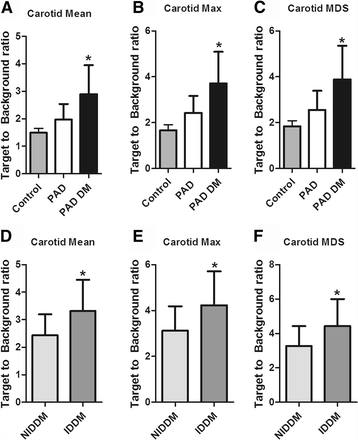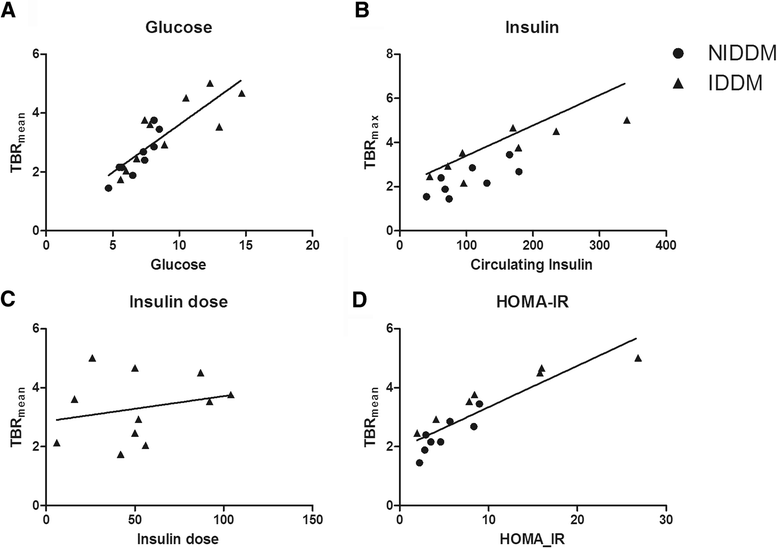Carotid arterial wall inflammation in peripheral artery disease is augmented by type 2 diabetes: a cross-sectional study
- PMID: 27887576
- PMCID: PMC5124245
- DOI: 10.1186/s12872-016-0397-x
Carotid arterial wall inflammation in peripheral artery disease is augmented by type 2 diabetes: a cross-sectional study
Abstract
Background: Patients with peripheral artery disease (PAD) are at increased risk of secondary events, which is exaggerated in the presence of type 2 diabetes mellitus. Diabetes is associated with a systemic pro-inflammatory state. We therefore investigated the cumulative impact of PAD and type 2 diabetes on carotid arterial wall inflammation. As recent data suggest a detrimental role of exogenous insulin on cardiovascular disease, we also included a group of insulin users.
Results: 18F-fluorodeoxyglucose positron emission tomography with computed tomography (18F-FDG PET/CT) imaging showed increased carotid arterial wall inflammation, assessed as target-to-background ratio (TBR), in PAD patients without diabetes (PAD-only: n = 11, 1.97 ± 0.57) compared with matched controls (n = 12, 1.49 ± 0.57; p = 0.009), with a significant further TBR increase in PAD patients with type 2 diabetes (PAD-DM, n = 23, 2.90 ± 1, p = 0.033 vs PAD-only). TBR of insulin users (n = 12, 3.31 ± 1.14) was higher compared with patients on oral medication only (n = 11, 2.44 ± 0.76, p = 0.035), despite comparable PAD severity (Fontaine stages), BMI and CRP. Multivariate regression analysis showed that Hba1c and plasma insulin levels, but not dose of exogenous insulin, correlated with TBR.
Conclusions: Concurrent diabetes significantly augments carotid arterial wall inflammation in PAD patients. A further increase in those requiring insulin was observed, which was associated with diabetes severity, rather than with the use of exogenous insulin itself.
Keywords: Diabetes mellitus; Imaging; Inflammation; Insulin; Peripheral vascular disease.
Figures


Similar articles
-
Arterial Stiffness Is Positively Associated With 18F-fluorodeoxyglucose Positron Emission Tomography-Assessed Subclinical Vascular Inflammation in People With Early Type 2 Diabetes.Diabetes Care. 2016 Aug;39(8):1440-7. doi: 10.2337/dc16-0327. Epub 2016 Jun 8. Diabetes Care. 2016. PMID: 27281773
-
Pioglitazone decreases coronary artery inflammation in impaired glucose tolerance and diabetes mellitus: evaluation by FDG-PET/CT imaging.JACC Cardiovasc Imaging. 2013 Nov;6(11):1172-82. doi: 10.1016/j.jcmg.2013.09.004. JACC Cardiovasc Imaging. 2013. PMID: 24229770 Clinical Trial.
-
Traditional and non-traditional risk factors for peripheral artery disease development/progression in patients with type 2 diabetes: the Rio de Janeiro type 2 diabetes cohort study.Cardiovasc Diabetol. 2021 Feb 27;20(1):54. doi: 10.1186/s12933-021-01249-y. Cardiovasc Diabetol. 2021. PMID: 33639945 Free PMC article.
-
Diabetes- versus smoking-related thrombo-inflammation in peripheral artery disease.Cardiovasc Diabetol. 2023 Sep 21;22(1):257. doi: 10.1186/s12933-023-01990-6. Cardiovasc Diabetol. 2023. PMID: 37735399 Free PMC article. Review.
-
Patients with Diabetes Complicated by Peripheral Artery Disease: the Current State of Knowledge on Physiotherapy Interventions.J Diabetes Res. 2021 May 10;2021:5122494. doi: 10.1155/2021/5122494. eCollection 2021. J Diabetes Res. 2021. PMID: 34056006 Free PMC article. Review.
Cited by
-
Atherosclerosis Burdens in Diabetes Mellitus: Assessment by PET Imaging.Int J Mol Sci. 2022 Sep 6;23(18):10268. doi: 10.3390/ijms231810268. Int J Mol Sci. 2022. PMID: 36142181 Free PMC article. Review.
-
A role for artificial intelligence in molecular imaging of infection and inflammation.Eur J Hybrid Imaging. 2022 Sep 1;6(1):17. doi: 10.1186/s41824-022-00138-1. Eur J Hybrid Imaging. 2022. PMID: 36045228 Free PMC article. Review.
-
Pancreatic 18F-FDG uptake is increased in type 2 diabetes patients compared to non-diabetic controls.PLoS One. 2019 Mar 19;14(3):e0213202. doi: 10.1371/journal.pone.0213202. eCollection 2019. PLoS One. 2019. PMID: 30889184 Free PMC article.
-
PET imaging of the neurovascular interface in cerebrovascular disease.Nat Rev Neurol. 2017 Nov;13(11):676-688. doi: 10.1038/nrneurol.2017.129. Epub 2017 Oct 6. Nat Rev Neurol. 2017. PMID: 28984315 Review.
References
-
- Stoekenbroek RM, Boekholdt SM, Luben R, Hovingh GK, Zwinderman AH, Wareham NJ, et al. Heterogeneous impact of classic atherosclerotic risk factors on different arterial territories: the EPIC-Norfolk prospective population study. Eur Heart J. 2016;37:880–9. doi: 10.1093/eurheartj/ehv630. - DOI - PubMed
Publication types
MeSH terms
Substances
LinkOut - more resources
Full Text Sources
Other Literature Sources
Medical
Research Materials
Miscellaneous

